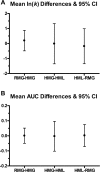Congruence of BOLD response across intertemporal choice conditions: fictive and real money gains and losses
- PMID: 19587291
- PMCID: PMC2749994
- DOI: 10.1523/JNEUROSCI.5319-08.2009
Congruence of BOLD response across intertemporal choice conditions: fictive and real money gains and losses
Abstract
Intertemporal choice is predicated on the valuation of commodities with respect to delay until their receipt. Subjective value of a future outcome decreases, or is discounted, as a function of that delay (Bickel and Johnson, 2003). Although behavioral studies suggest no difference between the devaluation of real and fictive outcomes, no neuroimaging studies have investigated potential differences in the underlying deliberative process. Here, we compare behavioral and neural correlates of intertemporal valuation of real and hypothetical monetary gains as well as hypothetical losses, which have been posited to involve different mechanisms. Behavioral and neuroimaging sessions were conducted in which participants made intertemporal choice decisions in a gains condition using both real and hypothetical $100 money and in a loss condition using a fictive $100 money. Within-subject comparison of behavioral data revealed no significant difference between levels of discounting across the three conditions. Random-effects analysis of functional magnetic resonance imaging (fMRI) data of each of the three discounting conditions independently revealed significant signal change in limbic (anterior cingulate, striatum, posterior cingulate) and executive functioning areas (lateral prefrontal cortex), whereas a repeated-measures ANOVA failed to detect differences in signal change across the three discounting conditions after correcting for multiple comparisons. These data support a concordance between real and hypothetical conditions from delay-discounting studies and further suggest a congruence of the fMRI blood oxygen level-dependent signal across brain regions associated with the deliberative process of different forms of intertemporal choice.
Figures



Similar articles
-
Neural mechanism of intertemporal choice: from discounting future gains to future losses.Brain Res. 2009 Mar 19;1261:65-74. doi: 10.1016/j.brainres.2008.12.061. Epub 2009 Jan 6. Brain Res. 2009. PMID: 19185567
-
The Attraction Effect Modulates Reward Prediction Errors and Intertemporal Choices.J Neurosci. 2017 Jan 11;37(2):371-382. doi: 10.1523/JNEUROSCI.2532-16.2016. J Neurosci. 2017. PMID: 28077716 Free PMC article.
-
Separate Neural Networks for Gains and Losses in Intertemporal Choice.Neurosci Bull. 2018 Oct;34(5):725-735. doi: 10.1007/s12264-018-0267-x. Epub 2018 Aug 7. Neurosci Bull. 2018. PMID: 30088149 Free PMC article.
-
Common neural correlates of intertemporal choices and intelligence in adolescents.J Cogn Neurosci. 2015 Feb;27(2):387-99. doi: 10.1162/jocn_a_00698. J Cogn Neurosci. 2015. PMID: 25208743
-
The neurobiology of intertemporal choice: insight from imaging and lesion studies.Rev Neurosci. 2011;22(5):565-74. doi: 10.1515/RNS.2011.046. Rev Neurosci. 2011. PMID: 21967518 Review.
Cited by
-
Delay discounting decreases in those completing treatment for opioid dependence.Exp Clin Psychopharmacol. 2012 Aug;20(4):302-9. doi: 10.1037/a0027391. Epub 2012 Feb 27. Exp Clin Psychopharmacol. 2012. PMID: 22369670 Free PMC article.
-
Hierarchical brain networks active in approach and avoidance goal pursuit.Front Hum Neurosci. 2013 Jun 17;7:284. doi: 10.3389/fnhum.2013.00284. eCollection 2013. Front Hum Neurosci. 2013. PMID: 23785328 Free PMC article.
-
Individual Differences in Delay Discounting are Associated with Dorsal Prefrontal Cortex Connectivity in Youth.bioRxiv [Preprint]. 2023 Jan 26:2023.01.25.525577. doi: 10.1101/2023.01.25.525577. bioRxiv. 2023. Update in: Dev Cogn Neurosci. 2023 Aug;62:101265. doi: 10.1016/j.dcn.2023.101265. PMID: 36747838 Free PMC article. Updated. Preprint.
-
Can delay discounting predict vaccine hesitancy 4-years later? A study among US young adults.Prev Med Rep. 2023 Jun 11;35:102280. doi: 10.1016/j.pmedr.2023.102280. eCollection 2023 Oct. Prev Med Rep. 2023. PMID: 37576839 Free PMC article.
-
Remember the future II: meta-analyses and functional overlap of working memory and delay discounting.Biol Psychiatry. 2014 Mar 15;75(6):435-48. doi: 10.1016/j.biopsych.2013.08.008. Epub 2013 Sep 13. Biol Psychiatry. 2014. PMID: 24041504 Free PMC article. Review.
References
-
- Ainslie G, Haendel V. The motives of the will. In: Gottheil E, Druley K, Skodola T, Waxman H, editors. Etiology aspects of alcohol and drug abuse. Springfield, IL: Charles C. Thomas; 1983.
-
- Baker F, Johnson MW, Bickel WK. Delay discounting in current and never-before cigarette smokers: similarities and differences across commodity, sign, and magnitude. J Abnorm Psychol. 2003;112:382–392. - PubMed
-
- Berridge CW, Waterhouse BD. The locus coeruleus-noradrenergic system: modulation of behavioral state and state-dependent cognitive processes. Brain Res Brain Res Rev. 2003;42:33–84. - PubMed
-
- Bickel WK, Johnson MW. Junk time: pathological behavior as the interaction of evolutionary and cultural forces. In: Heather N, Vuchinich R, editors. Choice, behavioral economics and addictions. Amsterdam: Pergamon; 2003. pp. 249–271.
-
- Bickel WK, Marsch LA. Toward a behavioral economic understanding of drug dependence: delay discounting processes. Addiction. 2001;96:73–86. - PubMed
Publication types
MeSH terms
Grants and funding
LinkOut - more resources
Full Text Sources
Medical
